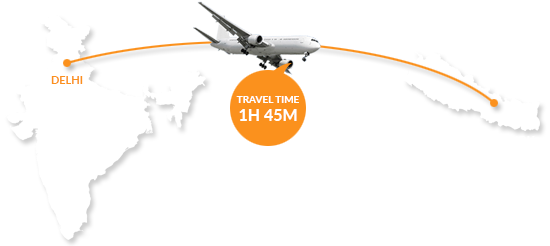MBBS in Nepal
Affordable medical education with growing international recognition in a culturally rich environment.
Study Medicine in Nepal
About Medical Education in Nepal
Nepal has emerged as a popular destination for international medical students due to its affordable education costs and quality instruction. The country's medical programs have gained recognition globally, with many graduates successfully practicing in various countries. The rich cultural heritage and natural beauty of Nepal provide a unique living experience for international students.
With a rich heritage in medical education, Nepal has become a hub for aspiring doctors from around the world. The country's medical universities offer a perfect blend of theoretical knowledge and practical training, preparing students for successful careers in medicine globally. The affordable tuition fees combined with high-quality education make it an attractive destination for international medical students.
Key Highlights
- WHO-recognized medical degrees
- English-medium instruction
- Affordable tuition fees and living costs
- Modern teaching facilities and methodology
- Clinical training in affiliated teaching hospitals
- Diverse international student community
- Scholarships available for international students
- Safe and welcoming environment for students

Medical Education System
Medical education in Nepal follows a 5.5-year MBBS program (including a one-year internship). The curriculum blends theoretical learning with practical experience in both hospital and community settings. Education is primarily delivered in English, making it accessible to international students....
Curriculum Structure
- Basic Medical Sciences (Years 1-2)
- Pre-Clinical Studies (Year 3)
- Clinical Rotations (Years 4-5)
- Internship/Residency (Year 6)
Why Study Medicine in Nepal?
Admission Requirements for International Students
Academic Requirements
- Completion of 12 years of education (10+2) with Physics, Chemistry, and Biology
- Minimum 50% aggregate marks in science subjects
- Medical entrance examination
- Interview
- English proficiency test for non-native speakers
Admission Process Timeline
- Research and Selection 6-8 months before program start
- Document Preparation 4-6 months before program start
- Application Submission 3-5 months before program start
- Admission Decision 2-3 months before program start
- Visa Application 1-2 months before program start
Application Process for Medical Universities in Nepal
- Entrance Examination: Complete entrance exams if required by the university.
- Interview: Attend interviews either in-person or online as scheduled by the admissions committee.
- Acceptance: Upon acceptance, pay the required tuition fees to secure your seat.
- Visa Application: Apply for a student visa with the acceptance letter and other required documents.
- Pre-departure Arrangements: Make accommodation arrangements, book flights, and prepare for your journey.
- Research and Selection: Research and select universities that match your preferences, budget, and admission requirements.
- Document Preparation: Prepare necessary documents including academic transcripts, passport, medical certificates, and passport-sized photographs.
- Application Submission: Submit applications directly to universities or through their online portals within the application deadlines.
- Application Fee Payment: Pay application fees as required by each university.
Medical education in Nepal follows a 5.5-year MBBS program (including a one-year internship). The curriculum blends theoretical learning with practical experience in both hospital and community settings. Education is primarily delivered in English, making it accessible to international students.
Program Structure
Pre-Clinical Phase (Years 1-3)
Clinical Phase (Years 4-5)
Internship Year (Year 6)
Key Features
- English-medium instruction
- Globally recognized curriculum
- Modern laboratory facilities
- Clinical training in teaching hospitals
- Experienced international faculty
- Emphasis on research opportunities
- Regular assessments and evaluations
Academic Calendar
Teaching Methodology
Modern Approach to Medical Education
Medical universities in Nepal employ a blend of traditional teaching methods and modern educational approaches. Students benefit from lecture-based learning, small group tutorials, problem-based learning sessions, and simulation-based training.
Clinical Training
Clinical training begins early in the curriculum with observerships in the first years, followed by extensive clinical rotations in the later years. Students gain experience in various medical specialties across different healthcare settings, from primary care facilities to specialized hospitals.
Technological Integration
Universities are equipped with digital learning resources, online libraries, virtual anatomy labs, and medical simulation centers. These technological tools enhance the learning experience and prepare students for modern medical practice.
Assessment Methods
Student performance is evaluated through multiple assessment methods including written exams, practical assessments, clinical skills evaluations, case presentations, research projects, and continuous assessments throughout the academic year.
Medical Degree Recognition
Medical degrees from Nepal are recognized by various international bodies and medical councils, allowing graduates to practice globally after completing the necessary licensing requirements.
WHO
World Health Organization
ECFMG
Educational Commission for Foreign Medical Graduates
GMC
General Medical Council (UK)
MCI
Medical Council of India
Post-Graduation Opportunities
After completing their medical degree in Nepal, graduates have various options for further education and career development:
- Residency programs in Nepal or abroad
- Specialized medical training in various fields
- Research opportunities in medical sciences
- Return to home country for medical practice
- Preparation for licensing exams such as USMLE, PLAB, or MCI
- Student Life & Living Costs
Accommodation
Transportation
Utilities
Internet & Phone
Entertainment
Personal Expenses
Total Monthly Expenses Approximately
Accommodation Options
University Dormitories
Most universities offer on-campus dormitories at affordable rates. These typically cost between $100-$200 per month depending on whether they are shared or private rooms. Dormitories often include basic utilities.
Shared Apartments
Many international students choose to share rental apartments near the university. Sharing with 2-3 other students can cost $150-$250 per month per person, excluding utilities.
Private Apartments
For those preferring more privacy, studio or one-bedroom apartments typically range from $250-$450 per month, depending on location and amenities.
Pro Tip
Most universities provide accommodation assistance services for international students. We recommend contacting the university's international student office for guidance before arranging accommodation.
MBBS in Nepal Fees Structure 2025-2026
| Name of the University | Recognition | Tuition Fees For 5 Years |
| KIST Medical College | Tribhuvan University | 45 to 55 Lakh |
| National Medical College | Tribhuvan University | 60 to 65 Lakh |
| Devdaha Medical College | Kathmandu University | 50 to 55 Lakh |
| Nepalganj Medical College | Kathmandu University | 55 to 60 Lakh |
| Chitwan Medical College | Tribhuvan University | 50 to 60 Lakh |
| Birat Medical College & Teaching Hospital | Kathmandu University | 50 to 60 Lakh |
| Manipal College of Medical Sciences | Kathmandu University | 55 to 65 Lakh |
| Lumbini Medical College & Research Center | Kathmandu University | 50 to 60 Lakh |
| B.P. Koirala Institute of Health Sciences | - | 40 to 50 Lakh |
| Institute of Medicine | Tribhuvan University | 40 to 50 Lakh |
| Nobel Medical College | Kathmandu University | 50 to 60 Lakh |
| Gandaki Medical College | Tribhuvan University | 50 to 60 Lakh |
| Janaki Medical College | Tribhuvan University | 45 to 55 Lakh |
| Kathmandu Medical College | Kathmandu University | 50 to 60 Lakh |
| Nepal Medical College & Teaching Hospital | Kathmandu University | 50 to 60 Lakh |
| Universal College of Medical Sciences | Tribhuvan University | 55 to 65 Lakh |
| Kathmandu University School of Medical Sciences | Kathmandu University | 45 to 55 Lakh |
| Kathmandu National Medical College | Kathmandu University | 45 to 55 Lakh |
| Intake | September |
| Minimum Percentage Required | 60% in PCB |
| NEET Requirement | Yes With Qualifying Marks |
| Entrance Exam | Yes |
| Processing Time | 90 Days |
| Total Fees | 50 - 60 Lacs |
| Living Cost in Nepal | 100 USD Per Month |
| Duration | 6 Years |
| Medium of Instruction | English |
| Top MBBS Universities in Nepal | All Government & Private University |
| Recognition | NMC and WHO Approved |
Post-Arrival Procedures
After arriving in Nepal, international students must complete several important procedures:
Registration with Local Authorities
International students must register with local migration authorities within 5 business days of arrival. Your university's international office can assist with this process.
Medical Insurance
Obtain or validate your medical insurance within the first week of arrival. This is mandatory for all international students.
Medical Insurance
Obtain or validate your medical insurance within the first week of arrival. This is mandatory for all international students.
Opening a Bank Account
Opening a local bank account will make financial management easier during your stay.
Visa Extensions
Student visas are typically issued for one year initially and need to be extended annually. Your university's international student office will guide you through the extension process, which usually requires proof of continued enrollment and good academic standing.

❓FAQs
Frequently Asked Questions
24 / 7 ADMISSION HELPLINE: +91 (0)91133 70560
Get Expert Guidance for MBBS Admissions
Our expert counselors are here to help you with personalized guidance for your medical education journey. Fill the form to schedule a free counseling session.
Why Choose Medical Education Global?
- Expert guidance from medical professionals
- Personalized counseling for your specific needs
- Transparent process with no hidden costs
- Comprehensive support throughout your journey
- High success rate of admissions
